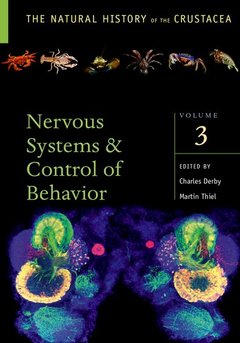Description
Crustacean Nervous Systems and Their Control of Behavior
The Natural History of the Crustacea Series
Coordinators: Derby Charles, Thiel Martin
Language: English
Subjects for Crustacean Nervous Systems and Their Control of Behavior:
Publication date: 11-2014
592 p. · 25.4x18.3 cm · Hardback
592 p. · 25.4x18.3 cm · Hardback
Description
/li>Biography
/li>
Crustacean Nervous Systems and their Control of Behavior is the third volume of the series The Natural History of the Crustacea. This volume is on the functional organization of crustacean nervous systems, and how those nervous systems produce behavior. It complements other volumes on related topics of feeding biology, reproductive biology, endocrine systems, and behavioral ecology. There is a rich history of the study of the neurobiology of crustaceans, going back over 150 years. This has included studies on how their nervous systems allow them to perform behaviors that are adapted to their particular environments, as well as studying them as model organisms to understand basic biomedical principles about neural function, such as sensory transduction and processing, synaptic transmission and integration, neuromodulation, and learning and memory. The volume has three sections that build progressively on each other. The first section is on the basic organizational features of the crustacean nervous system and the principles upon which it is built. The second section is on sensory ecology - the organization of each sensory system and how it is used in intra- and interspecific interactions, within an ecological context. The third section uses case studies of how crustacean nervous systems are organized to perform complex behaviors and interactions, such as walking, escape, social interactions, and memory and learning. Taken together, the 20 chapters synthesize our modern understanding of the neural control of behavior in crustaceans, based on the most recent technologies in physiological recording, molecular biology, and computational science. This volume will be useful to students and researchers as a concise summary of current knowledge of crustacean neuroscience.
Martin Thiel is a marine biologist with strong interests in animal behavior and natural history. During the past 20 years, he has conducted studies on crustacean behavior ranging from evolution of parental care behaviors to mating interactions and anti-predator behaviors. He is also interested in dispersal ecology and biogeography, and in promoting the participation of citizen scientists in marine research. Charles Derby is a Regents Professor of Neuroscience and Biology at Georgia State University who studies how animals use sensory information in solving life's challenges, such as finding high-quality food, identifying mates, and avoiding predators. His focus has been the chemical senses of decapod crustaceans, especially spiny lobsters, clawes lobsters, and brachyuran crabs.
© 2024 LAVOISIER S.A.S.
These books may interest you

Issues of Decapod Crustacean Biology 158.24 €



